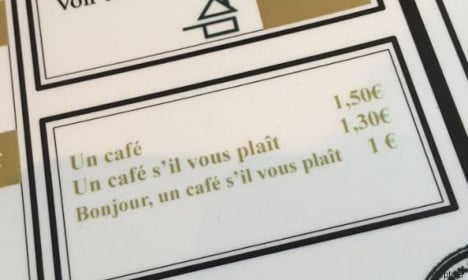Antonio Ferrari, who runs the restaurant in Padua, northern Italy, told The Local that the discount was a way of showing his customers “we like having children here – as long as they behave”.
“When you get parents who are rude, the kids think they can do anything. They might climb on the tables with their shoes on, play in the bathroom and make a mess with the taps, or annoy the other customers,” explains Ferrari, who has been managing the eatery for 12 years.
“We don't often get well-behaved children,” he added, but said he and his staff make a conscious effort to welcome younger diners, often cooking them dishes that aren’t on the menu in order to cater for younger palettes.
“The restaurant is essentially an enoteca (winery). We don't have a children's menu or any other special provisions, but on Sundays, parents often come and bring their children,” said the 40-year-old restaurateur.
He explained that on Sunday, the table of six adults and five children aged around four to six years old were a “delight” to serve, and he was particularly impressed when, after finishing their meals, the children worked on their times tables and colouring books as the parents drank their wine.
His inspiration for the five percent discount came from a bar he had recently visited in Miami which used a similar scheme. It was also an alternative to saying something to the family, which he feared might offend either the family or other diners.
Il titolare dell'enoteca che ha fatto lo sconto bimbi educati: «Guardarli era uno spettacolo» @Corriere https://t.co/ucJ5RttxWM
— Elvira Serra (@elvira_serra) February 14, 2017
A picture of the receipt shared on Twitter shows the €13.05 discount.
“In Italy, we have a problem that people often feel judged, so I didn't want to say anything – even positive – that might be seen as judging someone's children or parenting,” said Ferrari. “I'd definitely offer the discount again, but I don't want to make it an official promotion or offer because that's not the point.”
He told The Local that the initiative had gained lots of attention from Italian media, which had “built it up” – perhaps because Italian eateries are better known for adding sneaky cover charges than discounts for exemplary customers.
Foreigners are particularly prone to being stung by the additional fees – usually for sitting at a table in cafes, rather than knocking back an espresso standing at the bar, as the locals do. This charge is usually around €1, but in the past, some cafe owners have been called out for hiking up that charge to catch out tourists who fail to scrutinize their menus.
In 2013, the news that a group of holidaymakers from the UK paid €64 for four ice-creams in Rome made global headlines – so much so they were later invited back to the capital by shame-faced authorities and treated like royalty.
But later that year when an American family of four complained at being charged €42 for ice cream, the bar's manager defended his pricing, telling The Local: “It's their fault…I advise foreigners to read the menu.”
And penalizing ill-mannered customers is an idea which has really taken off in France. One cafe became a social media hit when photos circulated of its menu, which charged less for customers who said 'please'.
The Nice cafe's manager told The Local: “I know people say that French service can be rude, but it's also true that customers can be rude when they're busy.”
While he said that he had never actually had to enforce the price scheme, the idea struck a chord in France, and plenty of other restaurants and cafes soon introduced tiered pricing based on manners.
READ MORE: How minding your manners in a French cafe can save you money





 Please whitelist us to continue reading.
Please whitelist us to continue reading.
Member comments